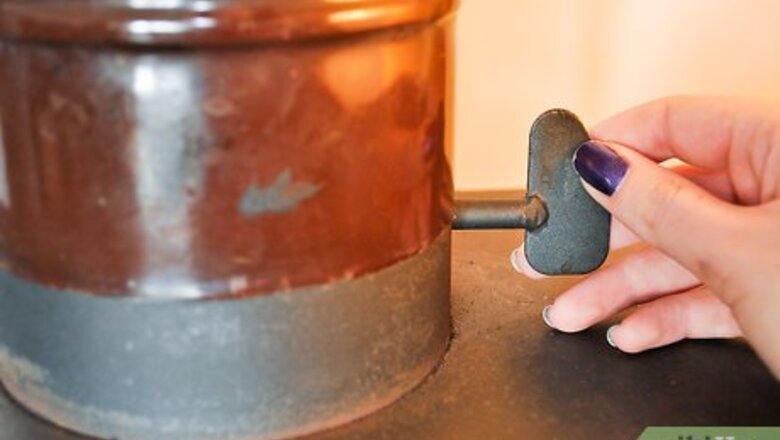
views
Starting a Fire with a Grate
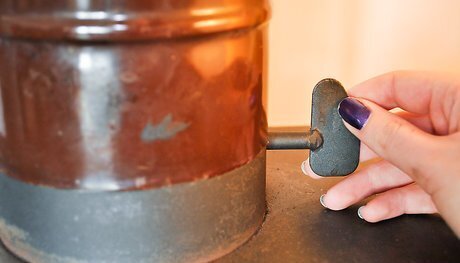
Check that the damper is open. The damper is a device that controls the amount of air flowing through the flue. The flue is the passage or duct for smoke in a chimney. Feel inside the chimney or pop your head inside to look at the damper with a flashlight. There should be a lever which you can try moving one way or the other. One direction will close the damper, the other will open it — check to see that the damper is open, or else smoke will pour back into the room. Also, make sure there are no obstructions. This is much easier to do before lighting a fire in there. Once you have determined that the damper is open, you are ready to get started.

Air out the fireplace before lighting it. If your fireplace has glass doors, open the doors 15 to 20 minutes before lighting your fire. This will allow the inside of the fireplace to come to room temperature. Cold air is heavier than warm air, so if the outside is too cold, it can create a river of cold air flowing down the chimney, into the fireplace, and trapped there by the doors. By opening the doors and allowing some warm air from your room to rise up the chimney, it may be enough to start the draft moving upwards.

Check the draft. Light a match near the opening of the flue and see if the draft is coming down or going up. If it is still coming down, you must find a way of reversing the draft and getting it to go up. Under no circumstances can you light the fire with the draft coming down. One method is to use a starter block (StarterLogg is one brand — break off a quarter of a stick) or a commercial wax log (such as Duraflame or Pine Mountain). These will light and stay lit, creating some warmth inside the firebox and helping the draft start upwards, and they burn with little smoke: Close the damper. This will stop the air from coming down and pushing the air into your living area. Put the block on the back of the fireplace shovel, light it and place it up inside the fireplace near the flue opening. What you are trying to do is to heat the upper part of the fireplace. Leave the flue damper closed at first to allow the fireplace to get to room temperature.
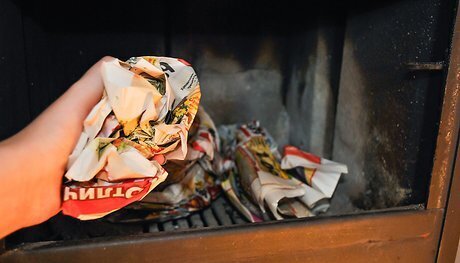
Set up the base of your fire with newspaper and other tinder. Newspaper or tinder will help light the fire and create plenty of flames in the beginning. Crumple up four or five pages of newspaper into light bundles and place them on the grate as bedding. Don't use too much, or you'll generate a lot of unnecessary smoke. If you don't have newspaper, you can use other Tinder to create flames. Tinder is light, dry material like dry moss, straw, tiny twigs, or newspaper that takes a spark. You can also use tinder that has sap in it, such as pieces of bark or pinecones. You can also use solid firestarters as tinder. Tinder catches fire first and burns very quickly. The key is to get enough tinder under the kindling so that the kindling begins to burn. Never use any kind of accelerant, such as lighter fluid, gasoline, or diesel when lighting a fire inside of the house.
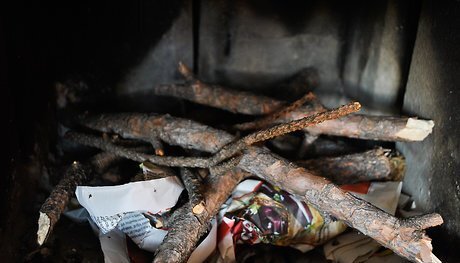
Stack kindling on your tinder in a grid. It is important to create a stable foundation for your larger logs. Kindling catches fire easier than big logs, helping generate a bigger flame in the beginning and sustaining the fire for a longer period of time. Be sure to stack your kindling horizontally. This means laying it down flat, not standing it up on end. Additionally, leave gaps for air to pass through. Air is fuel to a fire. Stack it in layers, criss-crossed. Stack two or three larger pieces of kindling on top of the newspaper, and then two or three more pieces on top of those at a perpendicular angle, creating a kind of grid. Continue stacking smaller pieces of kindling onto the grid, each new levels perpendicular to the last.
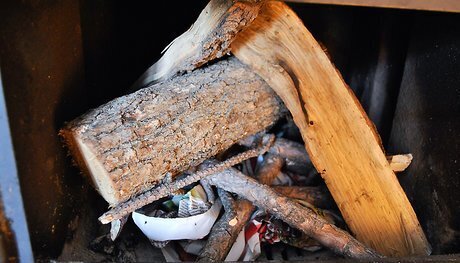
Stack one or two larger logs on top of your kindling base. Depending on your kindling placement, you may be able to fit a couple logs over your kindling securely. Generally, opt for smaller logs over larger ones. Larger logs may look nicer and be more fun to burn, but they have larger surface areas, making them tougher to catch fire. Two logs that are the size of one is almost always preferable. Stack the wood at most to half of the height of the fireplace. You don't want your fire to rage out of control when you light it, and you can always add more firewood as needed.
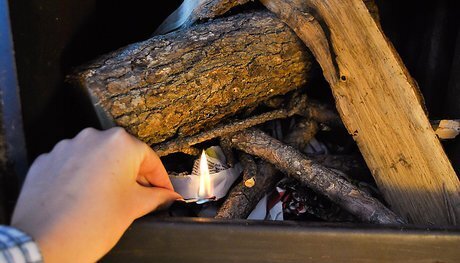
Light the newspaper first. The kindling lights from that. Watch the smoke carefully for the first half hour. The smoke should be nearly undetectable if it's drafting right up the chimney. If the smoke from the chimney turns black, the fire is not getting enough oxygen. Use your fireplace poker to lift the wood stack carefully; just pry it up a little, like jacking up a car. Take care here — all you need to do is allow some air to get under it. If your bed of coals underneath the grate is too high, use the poker to spread them out under the fire, leaving a couple of inches of air space. If the smoke is grey, most of the combustible material is escaping through the chimney instead of burning. You probably did not light the fire from above. You may have used wet wood. The fire is getting too much oxygen. Yes, this is confusing - fire is a delicate balance of air and fuel. When there's too much oxygen, the fire has a hard time catching hold of the fuel, and can make more smoke than normal.
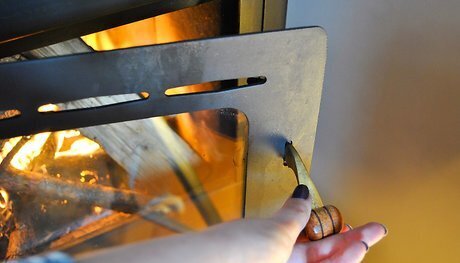
Open a window slightly. If you're still having trouble getting a good draft on the fireplace, and smoke is coming back into the room, try opening a window about an inch. This works best if the window is on a wall opposite the fireplace, with few obstructions — you will not want to have people seated between the window and fireplace. Sometimes, this breaks a kind of "vapor lock" on the room and allows the smoke to rise up the chimney. If people are between the fireplace and window, they will be chilled because the fireplace will start to suck air up. It will start pulling hard from that window, which will create a stream of cold air running between the window and fireplace. Stay out of the way and let it go — sometimes if the chimney isn't tall enough, this is the only way to get the draft running well and keep smoke out of the room. The rest of the room should stay warm, it's just the draft path that will be a little chilly.
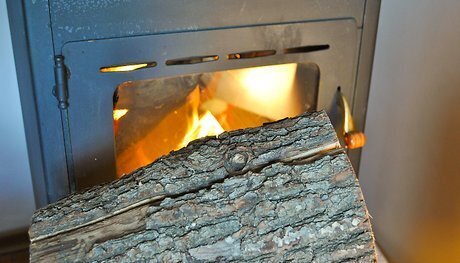
Add really big logs. If you're trying to enjoy an evening, you can make sure the fire will go a while without tending by building it properly to start with. Once the fire is going well, you should begin to see some red, glowing embers beneath the fire. As the smaller wood catches and the fire burns hot, grab a larger, thigh-sized piece of wood. Put that on top of the fire carefully, being as certain as possible that the stack is not leaning side to side any direction. The bigger wood takes a while to catch fire, but once it does, it will burn a long time without you having to get up and stir it or move it around. The glowing embers will keep things hot, and you should be nice and toasty for a couple of hours this way. Make sure that the logs cannot roll out of the fireplace. Your fireplace should have a heavy mesh spar resist curtain or other protective piece in front of it. Never leave the fire unattended either, just in case.
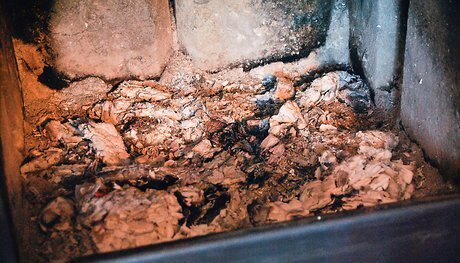
Stir the wood down at least half an hour before you want it to go out. Break it up with your poker and try to spread it out as much as you can over the area of the firebox. The thinner it's spread, the quicker it will burn up and go out. Check after the fire is out to insure that the coals and embers are all dead. If so, close the damper so that you do not lose valuable home heat through the chimney all day long.
Starting a Fire without a Grate

Put two large logs — the bigger the better — in parallel about 15 inches (38.1 cm) apart. Make sure they're perpendicular to the pane of the closed glass doors, or fireplace opening. These large logs will be the bed of the fire and contain the embers to feed it.
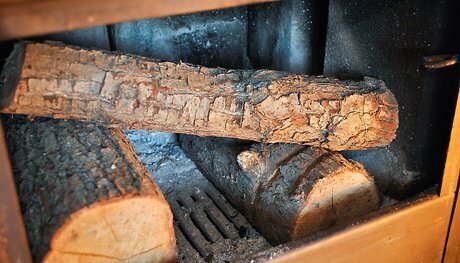
Place one cross-bar across the two large logs. This log should be about the diameter of your forearm, and it should rest parallel to the pane of the glass door or fireplace opening, closer to the opening of the fireplace. This cross-bar will hold the other firewood and keep an air vent open where the fire can draw fresh air to feed it from underneath.
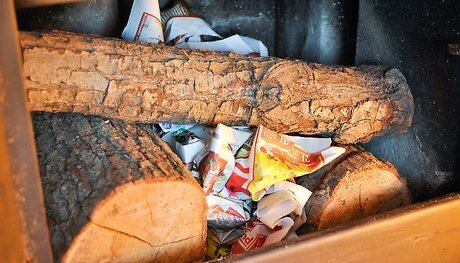
Crumple newspapers (not glossy paper) on the bottom of the fireplace. Alternately, use other tinder like dried twigs or wood shavings as a base.
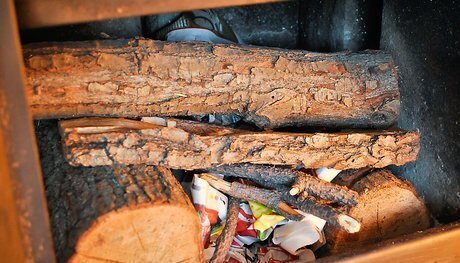
Place some kindling on top of the newspaper. Do not put any larger logs or fuel on top yet. If you can stack the kindling in a grid fashion, leaving plenty of space in between for air to pass through.

Light the fire from the newspaper or tinder. Make sure that the kindle starts to burn — you'll want to hear crackling noises.
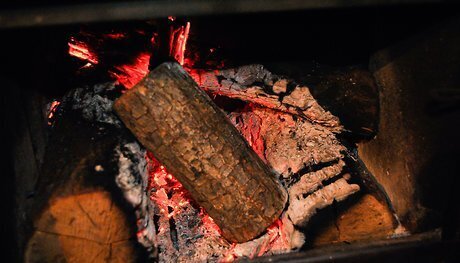
Place some logs in between the large logs on top of the cross-bar. Again, these logs should be (about half the diameter of your forearm, resting parallel with the cross-bar. Keep this arrangement at all times: two logs, one cross-bar on top and firewood held by the cross-bar. Make sure that the logs cannot roll out of the fireplace.

















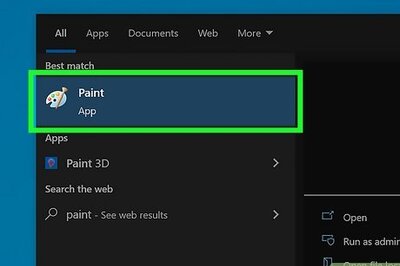

Comments
0 comment